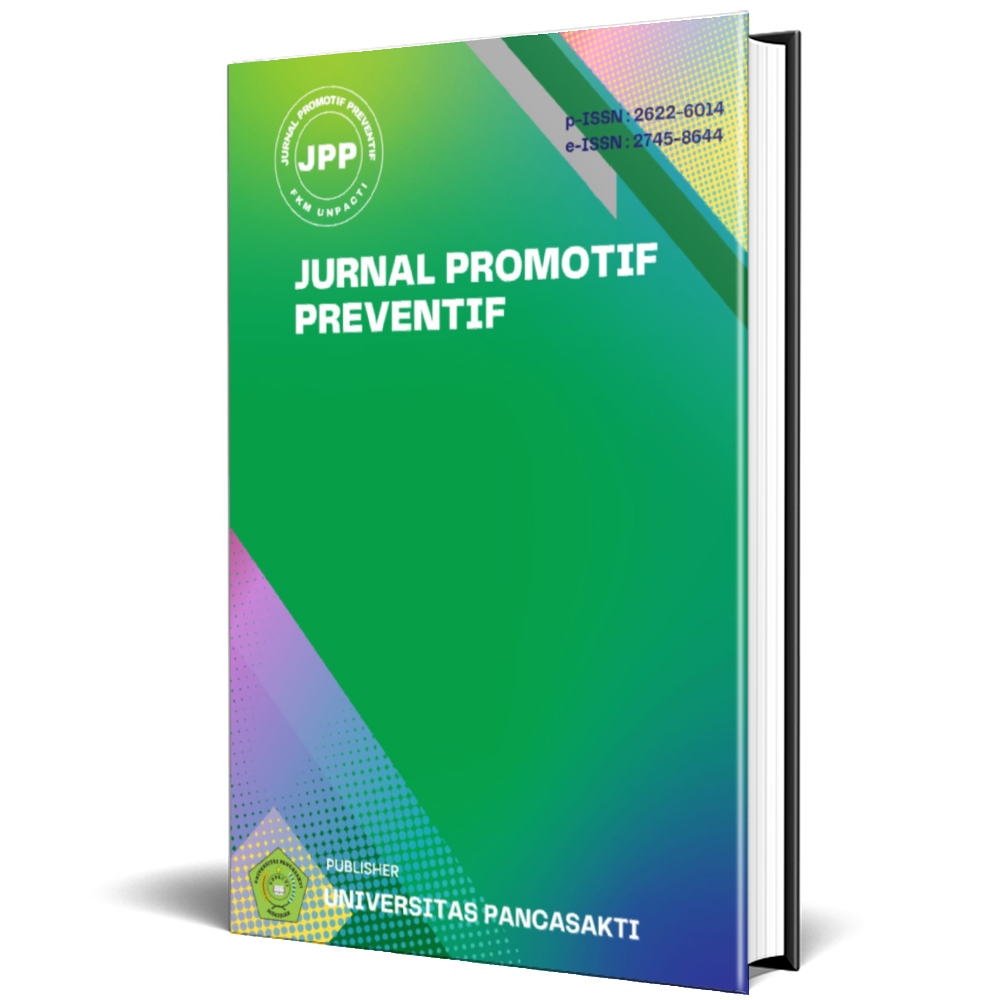Stigma dan Persepsi Masyarakat Terhadap Penderita Kusta: Studi Kualitatif di Kelurahan Kalibobo, Papua Tengah
Abstract
Penyakit kusta masih menjadi tantangan kesehatan masyarakat di Indonesia, khususnya di wilayah Papua Tengah yang memiliki prevalensi tinggi. Penelitian ini bertujuan untuk mengkaji persepsi masyarakat terhadap penderita kusta di Kelurahan Kalibobo, Distrik Nabire, Kabupaten Nabire. Pendekatan yang digunakan adalah kualitatif dengan desain fenomenologi melalui teknik wawancara mendalam terhadap 20 informan yang dipilih secara purposive sampling. Data dianalisis menggunakan model interaktif Miles dan Huberman dengan triangulasi sumber dan metode untuk menjamin validitas. Hasil penelitian menunjukkan bahwa sebagian besar masyarakat memiliki persepsi negatif berupa rasa takut, keyakinan terhadap mitos budaya, serta kecenderungan mengisolasi penderita kusta. Namun demikian, muncul pula sikap penerimaan bersyarat terhadap mereka yang menjalani pengobatan. Temuan ini menunjukkan perlunya strategi edukatif berbasis komunitas dan nilai lokal untuk mengurangi stigma serta mendorong integrasi sosial penderita kusta di masyarakat.
References
Alcántara, M.L.B., Corbett, C.E.P. & Brasil, M.S. (2024). Leprosy/Hanseníase: An interdisciplinary and epidemiological analysis Amazônia Paraense - Vila Santo Antônio do Prata-PA. International Journal of Research and Scientific Innovation, January. https://doi.org/10.51244/ijrsi.2024.11150025p
Arapu, V. (2023). Leprosy in the context of medical folklore and magical medicine (ethnocultural aspects). https://doi.org/10.52603/9789975841733.02
Arba, I.F., Hidayati, A.N., Soetjipto, S. & Damayanti, D. (2021). Stigma towards leprosy: A systematic review. Malaysian Journal of Medicine and Health Sciences, 17(3), pp.20-25.
Chandiok, T. (2024). Leprosy: A comprehensive review of epidemiology, diagnosis, and public health challenges. International Journal of Science and Research, June. https://doi.org/10.21275/sr24607111745
Creswell, J.W. (2014). Research Design: Qualitative, Quantitative, and Mixed Methods Approaches. 4th ed. Sage Publications.
Dessinioti, C. & Katsambas, A. (2015). Leprosy (Hansen's disease). In Textbook of Dermatology and Sexually Transmitted Diseases (pp. 757-763). https://doi.org/10.1007/978-3-662-45139-7_52
Dien, R., Krismawati, H., Ayomi, I., Timoria, D., Chambers, M.R., Soebono, H. & Grijsen, M.L. (2023). The unbreakable journey: Using photovoice to raise awareness and fight leprosy stigma in Papua, Indonesia. British Journal of Dermatology, 188(3), e122. https://doi.org/10.1093/bjd/ljad059
Fastenau, A., Rojas, C., Barreto, J., et al. (2024). Integrating community engagement in zero leprosy efforts: A pathway to sustainable early detection, control and elimination. Tropical Medicine and Infectious Disease, 9(12), p.296. https://doi.org/10.3390/tropicalmed9120296
Geetha, K. (2024). Zero leprosy strategic plans: Global and national level: A short communication. Clinical Dermatology Review, 8(1), pp.23-25. https://doi.org/10.4103/cdr.cdr_118_23
Jahnavi, G., Kumar, P. & Devi, R. (2019). Community perception on leprosy in the Islands. National Journal of Community Medicine, 10(1), pp.23-27.
Kazeem, O. & Adegun, T. (2011). Leprosy stigma: Ironing out the creases. Leprosy Review, 82(2), pp.103-109. https://doi.org/10.47276/LR.82.2.103
Lincoln, Y.S. & Guba, E.G. (1985). Naturalistic Inquiry. Sage Publications.
Lockwood, D.N.J. (2020). Leprosy (Hansen's disease). In Oxford Textbook of Medicine. https://doi.org/10.1093/med/9780198746690.003.0132
Marpaung, Y.M., Ernawati, E. & Dwivania, A.T. (2022). Stigma towards leprosy across seven life domains in Indonesia: A qualitative systematic review. BMJ Open, 12(11), e062372. https://doi.org/10.1136/bmjopen-2022-062372
Martamevia, W.D. (2024). Epidemiological overview of new cases of leprosy in West Java in 2021-2023, Indonesia. World Journal of Advanced Research and Reviews, 22(3), pp.150-157. https://doi.org/10.30574/wjarr.2024.22.3.1912
Miles, M.B. & Huberman, A.M. (1994). Qualitative Data Analysis: An Expanded Sourcebook. 2nd ed. Sage Publications.
Moleong, L.J. (2019). Metodologi Penelitian Kualitatif. Edisi Revisi. Remaja Rosdakarya.
Mostafa, H.M.A., El-Sayed, A., Khair, H.A. & Ahmed, M. (2023). A current perspective on leprosy (Hansen's disease). International Journal of Dermatology, Venereology and Leprosy Sciences, 6(2), pp.112-118. https://doi.org/10.33545/26649411.2023.v6.i2b.161
Moschella, S.L. (2006). Leprosy: Epidemiology and present and possible future therapeutic approaches. Drugs of the Future, 31(11), pp.1035-1044. https://doi.org/10.1358/DOF.2006.031.11.1036836
Prakoeswa, C.R.S., Rahmah, R., Fadli, M., et al. (2022). Epidemiology of leprosy in Indonesia: A retrospective study. Berkala Ilmu Kesehatan Kulit dan Kelamin, 34(1), pp.29-35. https://doi.org/10.20473/bikk.v34.1.2022.29-35
Soutar, D. (2008). Leprosy and human rights. Leprosy Review, 79(3), pp.239-245. https://doi.org/10.47276/LR.79.3.239
Staples, J. (2011). Interrogating leprosy 'stigma': Why qualitative insights are vital. Leprosy Review, 82(3), pp.91-97. https://doi.org/10.47276/LR.82.3.91
World Health Organization. (2023). Global Leprosy (Hansen's Disease) Strategy 2021-2030. WHO Press.
Copyright (c) 2025 Amna Mohamad, Suryadi Suryadi, Wardhana Wahyu Dharsono

This work is licensed under a Creative Commons Attribution-NonCommercial-ShareAlike 4.0 International License.


1.png)







